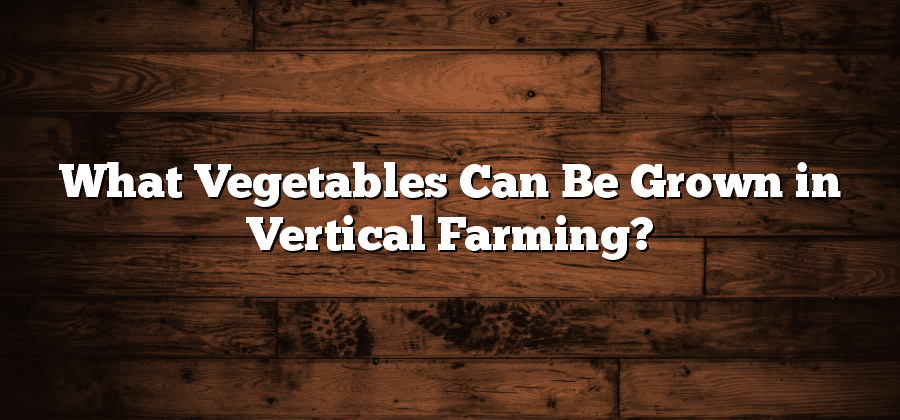Leafy Greens for Vertical Farming
Leafy greens have always been a staple in our diets, providing us with essential vitamins and nutrients. With the advancements in vertical farming technology, it is now easier than ever to grow these nutritious greens in a vertical farming system. The vertical farming approach allows for maximum space utilization while ensuring optimal growth conditions for the leafy greens.
One of the key benefits of growing leafy greens in a vertical farming setup is the ability to control the environmental factors. From temperature to humidity, light intensity to nutrient availability, every aspect can be fine-tuned to provide the ideal conditions for the plants’ growth. This level of precision ensures that the leafy greens receive the necessary elements to thrive, resulting in healthier and more flavorful produce. Additionally, vertical farming minimizes the risk of pests and diseases, as the controlled environment reduces the likelihood of infestations and allows for prompt intervention if needed. As a result, the leafy greens produced in vertical farms are not only delicious but also meet high-quality standards.
Root Vegetables in Vertical Farming
Vertical farming is a rapidly growing trend in sustainable agriculture that allows for the cultivation of a wide variety of crops, including root vegetables. These types of vegetables are known for their ability to grow below the surface of the soil, harnessing essential nutrients and flavors. Root vegetables such as carrots, beets, and radishes are highly adaptable to vertical farming systems, as they do not require much vertical space and can flourish in controlled environments.
One of the key advantages of growing root vegetables in vertical farming is the ability to optimize space utilization. With the use of vertical structures, farmers can grow these crops layer upon layer, effectively maximizing the production potential of their operations. This is particularly beneficial for urban areas with limited land availability, as it allows for high-density farming and increased yields. Additionally, vertical farming systems provide growers with precise control over environmental factors such as humidity, temperature, and light, creating optimal conditions for root vegetable growth. This level of precision ensures consistent and high-quality yields throughout the year.
Herbs Ideal for Vertical Farming
Growing herbs in vertical farming systems can be highly beneficial for indoor or urban farming enthusiasts. These aromatic plants are not only a delightful addition to any dish or culinary creation, but they also offer a range of therapeutic and medicinal properties. When it comes to vertical farming, herbs are particularly well-suited due to their compact size and minimal space requirements. With the right setup and care, herbs can flourish in limited vertical spaces and provide a fresh and fragrant addition to your indoor garden.
One of the key advantages of growing herbs in a vertical farming system is the ability to easily manage and control their growth. By utilizing vertical space, you can maximize the number of herbs you cultivate in a limited area. Additionally, vertical farming allows for convenient access to each plant, making it easier to tend to their specific needs. With proper lighting, irrigation, and nutrient delivery systems, you can create an optimal growing environment for your herbs, ensuring they receive the necessary conditions to thrive and flourish.
In conclusion, herbs are an excellent choice for vertical farming systems. They not only offer culinary value but also bring a touch of natural fragrance and visual appeal to indoor or urban gardens. With careful planning and implementation, herbs can be successfully grown in compact vertical spaces, allowing you to enjoy their freshness and reap the many benefits they offer. Whether you’re a culinary enthusiast looking to enhance your dishes or someone interested in natural remedies, incorporating herbs into your vertical farming setup is a choice that is sure to yield fruitful results.
Climbing Vegetables in Vertical Farming
Vertical farming offers a unique and space-efficient solution for growing climbing vegetables. With their natural tendency to reach upwards, climbers such as cucumbers, beans, and peas are particularly well-suited for vertical farming systems. By utilizing trellises or support structures, these plants can grow vertically, effectively maximizing the use of available space.
One of the key benefits of growing climbing vegetables in vertical farming is the ability to cultivate a larger yield in a smaller footprint. As these plants grow upwards, they utilize vertical space that would otherwise go unused in traditional agricultural practices. Additionally, vertical farming allows for precise control over environmental factors such as light, temperature, and humidity, creating optimal growing conditions for climbers. This controlled environment can result in higher productivity, improved quality, and reduced pest and disease pressure.
Compact Fruiting Vegetables for Vertical Farming
Compact fruiting vegetables are a popular choice for vertical farming due to their ability to thrive in limited space. These vegetables, such as cherry tomatoes, peppers, and eggplants, have compact growth habits and produce a bountiful harvest without sprawling vines. By utilizing vertical growing systems, these plants can be trained to grow upwards, maximizing space efficiency.
One advantage of growing compact fruiting vegetables vertically is the increased yield per square inch of farming area. In traditional farming methods, these vegetables would require a large amount of horizontal space to accommodate their spreading vines. However, in vertical farming, the plants can be trained to grow upwards using trellises or other support systems. This vertical growth not only saves space but also exposes a larger surface area of the plant to sunlight, allowing for better photosynthesis and nutrient absorption. As a result, vertical farmers can expect a higher yield from their compact fruiting vegetable crops.






